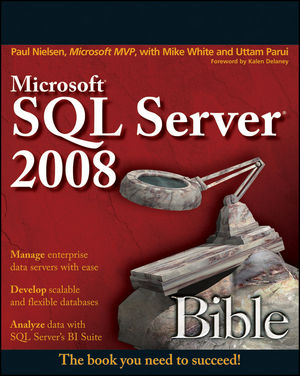Microsoft SQL Server 2008 BibleISBN: 978-0-470-25704-3
Paperback
1680 pages
August 2009
 This title is out-of-print and not currently available for purchase from this site.
|
Introduction.
Part I Laying the Foundation.
Chapter 1: The World of SQL Server.
Chapter 2: Data Architecture.
Chapter 3: Relational Database Design.
Chapter 4: Installing SQL Server 2008.
Chapter 5: Client Connectivity.
Chapter 6: Using Management Studio.
Chapter 7: Scripting with PowerShell.
Part II Manipulating Data with Select.
Chapter 8: Introducing Basic Query Flow.
Chapter 9: Data Types, Expressions, and Scalar Functions.
Chapter 10: Merging Data with Joins and Unions.
Chapter 11: Including Data with Subqueries and CTEs.
Chapter 12: Aggregating Data.
Chapter 13: Windowing and Ranking.
Chapter 14: Projecting Data Through Views.
Chapter 15: Modifying Data.
Chapter 16: Modification Obstacles.
Part III Beyond Relational.
Chapter 17: Traversing Hierarchies.
Chapter 18: Manipulating XML Data.
Chapter 19: Using Integrated Full-Text Search.
Part IV Developing with SQL Server.
Chapter 20: Creating the Physical Database Schema.
Chapter 21: Programming with T-SQL.
Chapter 22: Kill the Cursor!
Chapter 23: T-SQL Error Handling.
Chapter 24: Developing Stored Procedures.
Chapter 25: Building User-Defined Functions.
Chapter 26: Creating DML Triggers.
Chapter 27: DDL Triggers.
Chapter 28: Building Out the Data Abstraction Layer.
Chapter 29: Dynamic SQL and Code Generation.
Part V Data Connectivity.
Chapter 30: Bulk Operations.
Chapter 31: Executing Distributed Queries.
Chapter 32: Programming with ADO.NET 3.5.
Chapter 33: Sync Framework.
Chapter 34: LINQ.
Chapter 35: Asynchronous Messaging with Service Broker.
Chapter 36: Replicating Data.
Chapter 37: Performing ETL with Integration Services.
Chapter 38: Access as a Front End to SQL Server.
Part VI Enterprise Data Management.
Chapter 39: Configuring SQL Server.
Chapter 40: Policy-Based Management.
Chapter 41: Recovery Planning.
Chapter 42: Maintaining the Database.
Chapter 43: Automating Database Maintenance with SQL Server Agent.
Chapter 44: Transferring Databases.
Chapter 45: Database Snapshots.
Chapter 46: Log Shipping.
Chapter 47: Database Mirroring.
Chapter 48: Clustering.
Part VII Security.
Chapter 49: Authenticating Principals.
Chapter 50: Authorizing Securables.
Chapter 51: Data Cryptography.
Chapter 52: Row-Level Security.
Part VIII Monitoring and Auditing.
Chapter 53: Data Audit Triggers.
Chapter 54: Schema Audit Triggers.
Chapter 55: Performance Monitor.
Chapter 56: Tracing and Profiling.
Chapter 57: Wait States.
Chapter 58: Extended Events.
Chapter 59: Change Tracking.
Chapter 60: Change Data Capture.
Chapter 61: SQL Audit.
Chapter 62: Management Data Warehouse.
Part IX Performance Tuning and Optimization.
Chapter 63: Interpreting Query Execution Plans.
Chapter 64: Indexing Strategies.
Chapter 65: Query Plan Reuse.
Chapter 66: Managing Transactions, Locking, and Blocking.
Chapter 67: Data Compression.
Chapter 68: Partitioning.
Chapter 69: Resource Governor.
Part X Business Intelligence.
Chapter 70: BI Design.
Chapter 71: Building Multidimensional Cubes with Analysis Services.
Chapter 72: Programming MDX Queries.
Chapter 73: Authoring Reports with Reporting Services.
Chapter 74: Administering Reporting Services.
Chapter 75: Analyzing Data with Excel.
Chapter 76: Data Mining with Analysis Services.
Appendix A: SQL Server 2008 Specifications.
Appendix B: Using the Sample Databases.
Index.



